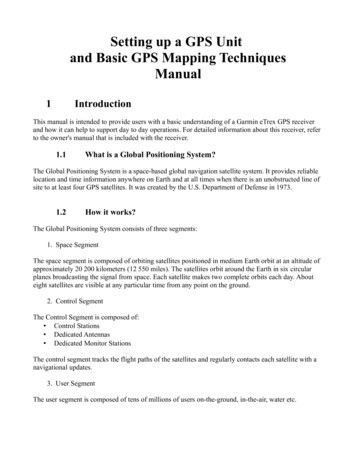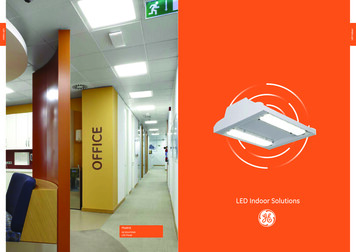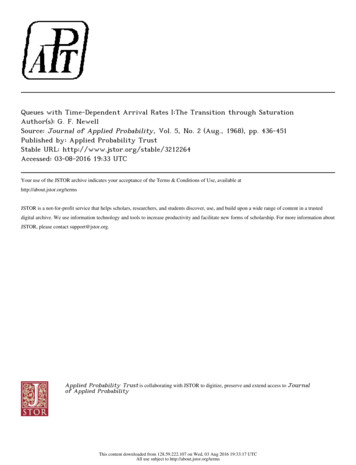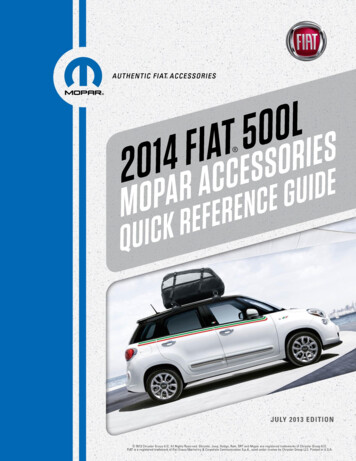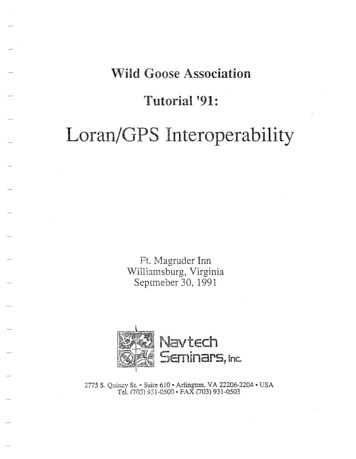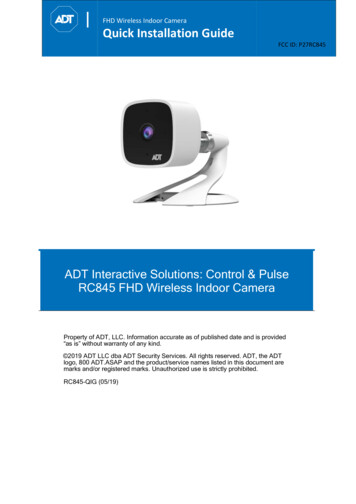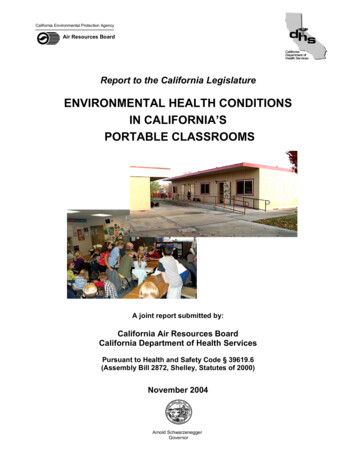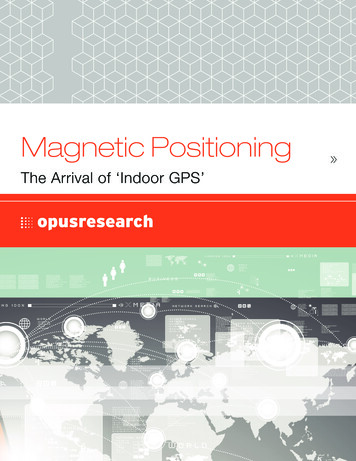
Transcription
Magnetic PositioningThe Arrival of ‘Indoor GPS’ Report»
Report »Magnetic Positioning»The Arrival of ‘Indoor GPS’Technologies for indoor location and offline analytics differ substantially in theircosts, capabilities, accuracy and longevity. But these technologies remain largelyundifferentiated in the minds of many brands, retailers and venue owners who’vehad limited exposure to them in the real-world. In this report, Opus Researchdelves deeply into one such technology, magnetic positioning, to understandhow it differs from its competitors in offering precision accuracy without anyhardware requirements and a relatively low total cost of ownership.June 2014Greg SterlingSenior Analyst, Internet2GoOpus Research, Inc.350 Brannan St., Suite 340San Francisco, CA 94107www.opusresearch.net Opus Research, Inc. All rights reserved.ii
Magnetic Positioning»» Table of ContentsMultiple Technologies, Market Confusion . . . . . . . . . . . . . . . . . .Mechanics of Magnetic Positioning . . . . . . . . . . . . . . . . . . . .The ‘Installation’ Process . . . . . . . . . . . . . . . . . . . . . . .Comparing Technologies: Magnetic, Wi-Fi, BLE . . . . . . . . . . . . . . . .In Search of the Indoor ‘Blue Dot’ . . . . . . . . . . . . . . . . . . . .The Potential of ‘Indoor Search’ . . . . . . . . . . . . . . . . . . . . .Stand Alone or Integrated with Wi-Fi, BLE . . . . . . . . . . . . . . . . .1234568List of FiguresFigure 1: Magnetic Fields Inside Buildings . . . . . . . . . . . . . . . . .Figure 2: Magnetically ‘Fingerprinting’ a Building . . . . . . . . . . . . . . .Figure 3: Comparing Technologies: WiFi, BLE and Magnetic . . . . . . . . . . . .Figure 4: Blue Dot Product Navigation . . . . . . . . . . . . . . . . . . .Figure 5: Methods Used for Mobile Product Research . . . . . . . . . . . . . .23567iii
Magnetic Positioning: The Arrival of ‘Indoor GPS’Multiple Technologies, Market ConfusionIndoor location could dramatically impact consumer wayfinding and the retail landscape in particular andredirect or capture some of the many billions spent on shopper marketing and merchandising. OpusResearch previously estimated that roughly 10 billion in annual marketing spending would potentially beimpacted by widespread adoption of indoor location and related initiatives.Yet U.S. consumers spend nearly 500 billion annually on grocery, personal care and various sundries,according to an analysis by Nielsen. This indicates the “indoor market” could be worth far more than 10billion over time – if indoor location and associated marketing can influence even a small percentage ofthese in-store transactions.It’s no surprise then that there are as many as 200 startups competing for visibility in the emergingindoor location and proximity marketing arena. In addition to the numerous companies there are multipletechnologies bringing indoor location and offline analytics to stores, malls, sports stadiums and othervenues. These technologies include cameras, Wi-Fi, Bluetooth beacons (e.g., iBeacon), inaudible soundwaves, LED lighting, magnetic positioning and "pedestrian dead reckoning," among others.All these technologies differ in their costs, capabilities, accuracy and longevity. Yet they remain largelyundifferentiated in the minds of many brands, retailers and venue owners who’ve had limited exposure tothem in the real world.Merchants just getting started with indoor location are typically unclear about their specific needs and whichtechnologies best match them. The array of available technologies, together with uncertainty about theircapabilities and accuracy are causing some hesitation among buyers in the market.Many retailers already have guest Wi-Fi, which can be used to locate consumers in stores (on Androiddevices) with roughly 40-feet accuracy. However, in order to achieve this consistently throughout thestore, most retailers would be required to install additional access points, which can be costly acrosshundreds of business locations. Apple does not provide a public API to collect Wi-Fi data.Bluetooth Low Energy (BLE) beacons, such as iBeacon, have recently been given tremendous attention andemerged as another way to offer indoor location services. Yet beacons have limitations. They can only detectand manage proximity between themselves and handset location. They can’t offer “blue dot” navigationinside a store or precise lat-long shopper coordinates.Beacons have lately received much of the attention because of Apple’s iBeacon. Beacon technology hasalso been or is being deployed by several high-profile entities such as Apple Stores, Major LeagueBaseball stadiums in the U.S. and retailers such as American Eagle Outfitters and Alex and Ani, amongothers.An indoor technology that has received less attention is “magnetic positioning.” It uses the Earth’s1
Magnetic Positioning: The Arrival of ‘Indoor GPS’»geomagnetic fields to enable the smartphone’s compass to precisely locate individuals within indoorspaces. It requires no hardware installation and is compatible with iOS devices.There’s currently only one startup pursuing this approach, IndoorAtlas. The company was founded in Finlandin 2012 but also has a U.S. headquarters in Mountain View, CA. It generally takes multiple companies to“make a market” (or market segment). Thus the fact that IndoorAtlas is the only company promoting anddeploying magnetic positioning may explain why relatively few people know about it or how it works.Mechanics of Magnetic PositioningMagnetic positioning was inspired by animal wayfinding in nature (e.g., birds, bats, bees, salmon,foxes, etc.). Animals rely upon the Earth’s magnetic fields to locate themselves in relation to theirdestinations (e.g., migratory breeding ground). Smartphones are similarly able to detect and respond tomagnetic field variations inside buildings.Each building or structure has a unique magnetic “fingerprint,” based on the way building materials affectand “distort” the otherwise persistent magnetic field generated by the Earth. Those patterns can beprecisely assigned to a building floor plan. Smartphone owners (iOS and Android) can then be accuratelylocated inside retail stores, hospitals, malls, airports and other indoor spaces.Figure 1: Magnetic Fields Inside BuildingsGRAPHIC #1SOURCE: IND OOR ATLA S (2014)Among those aware of magnetic positioning, there’s a relatively common perception that thedistortions caused by building materials such as steel and concrete will compromise accuracy.However, the opposite is true; IndoorAtlas says this distortion of the magnetic field is precisely whatenables it to locate people indoors.IndoorAtlas Founder and CEO Janne Harverninen told us, following an in-store demonstration, “Themore steel the better.” More steel actually improves the building’s “signal” and thus the technology’sability to accurately locate users. IndoorAtlas’ technology won’t work outdoors; it only works inside.2
»Magnetic Positioning: The Arrival of ‘Indoor GPS’As the company explains on its website, steel and concrete help create the unique magnetic fingerprints orsignatures of buildings:Modern buildings with reinforced concrete and steel structures have unique spatially varying ambientmagnetic fields that can be used for positioning, in very much the same way as the animals use Earth’smagnetic field, but on a smaller spatial scale. In principle, a non-uniform ambient magnetic field producesdifferent magnetic field observations, depending on the path taken through it.The company holds multiple patents for magnetic positioning. It says that, in contrast to Bluetooth beacons,magnetic positioning can in fact deliver “indoor GPS.”The ‘Installation’ ProcessThe company says magnetic positioning can maintain three to six feet accuracy (1-2 meters) in indoorenvironments. To support and prove that claim IndoorAtlas gave Opus Research a real world demonstrationin a major U.S. retail store currently testing magnetic positioning.The IndoorAtlas app running on an iPhone 5 maintained real-time location (exactly or within a few feet) aswe moved throughout the many areas and departments of the store. We were impressed by its consistentaccuracy during the course of our visit.As mentioned, the IndoorAtlas approach doesn’t require installation of any hardware. Nor does it seek torely on any existing hardware infrastructure. To “deploy” magnetic positioning, someone with a smartphoneand the IndoorAtlas app walks the floor(s) of a building or venue, collecting data. Each area of the structurehas a unique magnetic fingerprint.The building floor plan is then uploaded to the cloud and the magnetic fingerprint data associated with thatfloor plan. IndoorAtlas says that it takes about an hour to cover roughly 25,000 square feet of space for sixfeet accuracy. The company added that within minutes of the completion of a structure’s magneticfingerprinting, indoor location becomes commercially available.Even though IndoorAtlas’ core technology is independent from hardware, it can utilize Wi-Fi and BLE signalinformation when available. IndoorAtlas’ technology can thus supplement the existing indoor locationinfrastructure.Figure 2: Magnetically ‘Fingerprinting’ a BuildingSOURCE: INDOORATLAS (2014)3
Magnetic Positioning: The Arrival of ‘Indoor GPS’»If building or store interiors are remodeled or otherwise changed (e.g., by new layouts) IndoorAtlas says itis possible to update indoor maps automatically using sensor data straming into the cloud.Magnetic fingerprints can also potentially be crowdsourced. In other words, non-technical staff, volunteersor just ordinary people could generate magnetic fingerprints for indoor spaces simply by using an appon their smartphones – with little or no training or instruction. Beyond the lack of required hardware, thispossibility would allow the technology to globally scale more quickly. Waze (now part of Google) is a highprofile example of a successful app that uses this approach.A technique called Simultaneous Localization and Mapping (SLAM) could also be used to scale thetechnology without explicit indoor fingerprinting. It’s the same approach used to build maps when there’sno or little pre-existing knowledge of a place.Comparing Technologies: Magnetic, Wi-Fi, BLEAs marketers, retailers and venue owners evaluate which indoor technologies to test and deploy there are anumber of questions they need to ask: Are we only interested in indoor/location analytics? What level of location accuracy is required? (generally more accuracy is better) Will there be a consumer experience component? Are we interested blue dot consumer navigation? What level of accuracy is required? (generally, more accuracy is better) What is the total cost of ownership regarding the deployment and maintenanceof the chosen technology?Because of the variable circumstances, needs and budgets one generally cannot make a blanket indoorlocation technology recommendation in the abstract. The following chart seeks to compare magneticpositioning with the other major indoor technologies currently in the market, including Wi-Fi andBluetooth Low Energy.4
Magnetic Positioning: The Arrival of ‘Indoor GPS’»Figure 3: Comparing Technologies: WiFi, BLE and MagneticTechnologyAccuracyInfrastructureSet-Up gneticPositioning 6 feetSoftware/CloudAPI / minimalCrowdsourceNoneiOS/AndroidWiFi30 – 300 feetHardware/Soft- Triangulation /ware Remap FingerprintingElectricity/BatteryAndroid onlyBLE6 – 100 feet(no blue figurable/ PDR(pedestrianN/A SOURCE:OPUS RESEARCH,INDOORATLAS, VARIOUS COMPANY REPORTS (2014)Complementary Software/Cloud API / minimalCrowdsourcedeadreckoning)Other(cameras,LED, sound)VariableHardware/SoftwareMesh coverage Device Man/ agementIn Search of the Indoor ‘Blue Dot’One of the compelling use cases for BLE Beacons is that they can deliver push notifications to indoorshoppers even when apps are closed on the handset. What they cannot do, however, is deliver “X-Ycoordinates” for shoppers or products in a store. In other words, today’s beacons cannot be used to supportindoor “blue dot navigation.”Magnetic positioning can not only track shopper location, it can offer blue-dot navigation directly to an areaor product in an aisle or on the shelf. The customer experience benefits of in-store product navigation areobvious; so are the benefits to retailers. Roughly 15% of consumers leave stores or don’t buy because theycan’t find the product they’re looking for, according to research from Aisle 411. On an annual basis thatrepresents billions of dollars.5
Magnetic Positioning: The Arrival of ‘Indoor GPS’»Figure 4: Blue Dot Product NavigationSOURCE: INDOORATLAS (2014)The benefits of blue-dot accuracy in indoor environments are almostself-evident. Product or brand promotions can be surfacedon retailer apps or indoor maps at the aisle or shelf level, inappropriate context. Shopping list items in grocery or retail apps canalso be mapped to precise in-store floor locations.Basket size and conversion rates are likely to increase. For example,IndoorAtlas’ proof of concept store in Finland reports a 9.2%increase in basket size -- if only because consumers can more easilyfind products, especially if there’s no associate on the floor.Latent or inaccurate indoor location, by contrast, could meanpromotional messages or product information might be deliveredout of context. That could create a poor or even “spammy”customer experience, undermining the benefits of indoor location. Retailers will need to test technologiesand messaging tactics to avoid this. A full-scale consumer rollout can’t take place until some best practicesare discovered and established.The Potential of ‘Indoor Search’Blue dot accuracy opens up a broad array of marketing or customer experience possibilities to brands andvenue owners. One of those is to bring the search experience of the PC and paid-search-style ads to retailapps and stores.Consumers are accustomed to searching on their PCs and smartphones for products, services and businesslocations. While search engines (i.e., Google) are less frequently used on smartphones than on the PC,product search is still heavily relied upon in a mobile context.6
Magnetic Positioning: The Arrival of ‘Indoor GPS’»Figure 5: Methods Used for Mobile Product Research80%73%70%60%50%40%30%33%24%20%10%0%Mobile AppSpecific mobile websiteSearch EngineSOURCE: LOCAL CORP/E-TAILING GROUP (2014) N 1,300 U.S. SMARTPHONE OWNERS, NUMBERS TOTAL MORE THAN100% BECAUSE MULTIPLE RESPONSES WERE PERMITTEDA recent consumer survey, conducted by the e-Tailing Group confirmed that consumers very much rely onsearch when looking for product information on mobile devices. When asked how they sought out productson smartphones, survey respondents overwhelmingly reported “search engines” as the top method. A highdegree of indoor accuracy and the potential to surface and connect consumers to in-store promotions andproduct locations opens up the possibility of indoor search marketing opportunities.Consumers don’t need much of a push to search for product names, brands or categories in stores(especially grocery stores and big box retailers). They’re already doing it. This is the essence of so-called“showrooming” in retail stores.If the consumer is rewarded with accurate in-store content and product information, search on retailer appscould become a primary in-store shopping tool. But merchants must be able to connect products to their instore locations accurately. They must also deliver a reliable search experience.Regardless the opportunity is there to present competing brands and relevant ads among in-store searchresults similar to the existing paid-search model that generates a majority of Google’s more than 50 billionin annual revenue. Not only would the consumer experience benefit, it would open up additional revenuestreams, as competing brands offer to pay venue owners and retailers for relevant placement and visibility inapp-search results.7
Magnetic Positioning: The Arrival of ‘Indoor GPS’»As with any discussion of location technology there’s the persistent issue of privacy. We won’t explorethe privacy issue in depth in this report, except to say that merchants will need to be transparent andforthcoming about the use of consumer location and data. Merchants will also have to educate and “sell”the benefits of their apps and these new services to gain consumer opt-in.Stand Alone or Integrated with Wi-Fi, BLEIn the world of digital mapping and navigation, cell-tower triangulation, Wi-Fi and GPS all support oneanother behind the scenes to deliver more accurate location. The indoor example is similar.Merchants and venue owners will likely need two or more complementary technologies to allowindoor location to realize its potential.Magnetic positioning can be used as a stand-alone technology. It also integrates with the existing Wi-Fiinfrastructure as well as beacons.Of the technologies we’ve seen “in action” so far, magnetic positioning appears to be not only uniquebut the most complete and perhaps cost effective. It offers accuracy without any hardware requirementsand a relatively low total cost of ownership. Therefore, we believe that as more merchants, brands andmarketers become exposed to it, magnetic positioning will emerge as a “foundational” indoor locationtechnology.About Opus ResearchOpus Research is the leading IT industry analyst firm focused on indoor positioning, offlineanalytics and advanced mobile-location targeting. In addition, Opus Research covers“conversational commerce,” the merging of automated speech processing technologies,intelligent assistants, contact center automation, enterprise collaboration and mobilecommerce. www.opusresearch.netFor sales inquires please e-mail info@opusresearch.net or call 1 (415) 904-7666This report shall be used solely for internal information purposes. Reproduction of this report without prior written permission isforbidden. Access to this report is limited to the license terms agreed to originally and any changes must be agreed upon in writing.The information contained herein has been obtained from sources believe to be reliable. However, Opus Research, Inc. accepts noresponsibility whatsoever for the content or legality of the report. Opus Research, Inc. disclaims all warranties as to the accuracy,completeness or adequacy of such information. Further, Opus Research, Inc. shall have no liability for errors, omissions or inadequacies in the information contained herein or interpretations thereof. The opinions expressed herein may not necessarily coincidewith the opinions and viewpoints of Opus Research, Inc. and are subject to change without notice.Published June 2014 Opus Research, Inc. All rights reserved.8
magnetic fields that can be used for positioning, in very much the same way as the animals use Earth’s magnetic field, but on a smaller spatial scale. In principle, a non-uniform ambient magnetic field produces different magnetic field observations, depending on the path taken through it. The company
